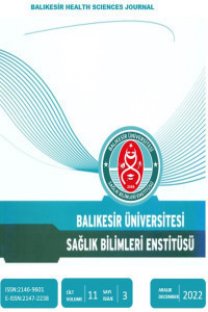Erken Bulgu Veren ancak Geç Tanı Konulan Bir Olgu; Ataksi Telenjiektazi
Ataksi-telenjiektazi hastalığı otozomal resesif genetik geçiş gösteren nörodejeneratif bir hastalıktır. Bu hastalığın ana bulgusu ilk yaşlarda ortaya çıkan trunkal ataksidir. Bakış kısıtlılığı şikayeti ile başvuran on bir yaşında erkek hastada dengesiz yürüme ve peltek konuşma tespit edildi. Hastada mental gerilik, dizartrik konuşma, trunkal ataksi, başta titubasyon, ellerde intansiyel tremor, horizantal/vertikal nistagmus, yüzde ve sklerada telenjiektazik damarlar, yukarı laterale bakış dışında diğer alanlarda bakış kısıtlılığı, dismetri, disdiadokinezi, kaba yüz görünümü olduğu belirlendi. Kranial magnetik rezonans görüntülemesinde her iki serebeller hemisferde atrofi tespit edildi. Alfa fetoprotein değeri 38 ng/ml (0.9-7.6) ile yüksekti. Ataksi Telenjiektazi ATM geni mutasyon analizinde 25. ekzonunda bulunan p. Lys1192Lys (c.3576 G>A) değişimini homozigot olarak saptandı. Ataksi, nöromotor retardasyon, telenjektazi ve göz bulgularının olduğu hastalarda Ataksi-telenjiektazi hastalığı ilk akla gelen tanılardan biri olmalıdır.
A Case Giving Early Findings, But Diagnosed Late: Ataxia Telangiectasia Ataxia Telangiectasia Case Report
Ataxia telangiectasia is a neurodegenerative disease exhibiting autosomal recessive genetic transmission. The principal finding ofthe disease is truncal ataxia emerging in the first years. Gait imbalance and lisp were determined in an 11-year-old boy presentingdue to gaze restriction. Mental retardation, dysarthric speech, truncal ataxia, titubation of the head, intention tremor in the hands,horizontal/vertical nystagmus, telangiectasia in the face/sclera, restriction in all gaze fields except for upward lateral, dysmetria,dysdiadochokinesia, and a coarse facial appearance were observed. Cranial magnetic resonance imaging revealed atrophy cerebralhemispheres. Alpha fetoprotein was elevated, at 38 ng/ml (0.9-7.6). Ataxia telangiectasia ATM gene mutation analysis reported ahomozygous p. Lys1192Lys (c.3576 G>A) change on the 25th exon. This case report is intended to emphasize that ataxiatelangiectasia should be the first condition considered at differential diagnosis in patients with ataxia, neuromotor retardation,telangiectasia, and ocular findings.
___
- Chun, H.H., & Gatti, R.A. (2004). Ataxia-telangiectasia, an evolving phenotype. DNA Repair, 3, 1187-96.
- Farina, L., Uggetti, C., Ottolini, A., Martelli, A., Bergamaschi, R., Sibilla, L., Zappoli, F., Egitto, M.G., & Lanzi, G. (1994). Ataxia telangiectasia: MR and CT findings. J Comput Assist Tomogr, 18, 724-7.
- Jason, J.M., & Gelfand, E.W. (1979). Diagnostic considerations in ataxia– telangiectasia. Arch Dis Child, 54, 682-6.
- Lange, E., Borresen, A., Chen, X., Chessa, L., Chılunkar, S., & Concannon, P. (1995). Localization of an Ataxiatelengiectasia gene to an approximately 500-kb interval on chromosome 11q23.1: linkage analysis of 176 families by an international consortium. Am J Human Genet, 57, 112-9.
- Larry, L., Smith, M.D., & Stephen, L. (1985). Ataxiatelangiactasia or Louis – Bar syndrome. J Am Acad Dermato, 12, 681-696.
- Lin, D.D., Barker, P.B., Lederman, H.M., & Crawford, T.O. (2014). Cerebral abnormalities in adults with ataxia– telangiectasia. Am. J. Neuroradiol, 35(1), 119–123.
- Rothblum-Oviatt, C., Wright, J., Lefton-Greif, M.A., McGrath- Morrow, S.A., Crawford, T.O., & Lederman, L.M. (2016). Ataxia telangiectasia: a review. Orpha. J. Rare Dis, 159.
- Suarez, F., Mahlaoui, N., Canioni, D., Andriamanga, C., Dubois d'Enghien, C., Brousse, N., Jais, J.P., Fischer, A., Hermine, O., & Stoppa-Lyonnet, D. (2015). Incidence, presentation, and prognosis of malignancies in ataxiatelangiectasia: a report from the French national registry of primary immune deficiencies. J. Clin. Oncol, 33(2), 202–208.
- Swift, M., Morrell, D., Cromartie, E., Chamberlin, A.R., Skolnick, M.H., & Bishop, D.T. (1986). The incidence and gene frequency of ataxia-telangiectasia in the United States. Am. J. Hum. Genet, 39(5), 573–583.
- Woods, C.G., & Taylor, A.M. (1992). Ataxia telangiectasia in the British Isles: the clinical and laboratory features of 70 affected individuals. Q J Med, 82, 169-79.
- ISSN: 2146-9601
- Yayın Aralığı: Yılda 3 Sayı
- Yayıncı: BALIKESİR ÜNİVERSİTESİ
Sayıdaki Diğer Makaleler
Birgül BALCI, Evrim GÖZ, Berril DÖNMEZ ÇOLAKOĞLU, Raif ÇAKMUR
Ergenlerde İnternet Bağımlılığını Etkileyen Faktörler
Hülya ARSLANTAŞ, Rüveyda YÜKSEL, Cihan KOCAİRİ, Barış SÖYLEMEZ
Suriyeli Çocuk Mülteciler ve Sorunları
Türkiye’de Sağlık Sisteminin Sorunları ve Çözüm Önerileri
Ebelik Öğrencilerinin Ebelik Mesleği Hakkindaki Görüşleri ve Mesleğe Yönelik Beklentileri
Funda ÇİTİL CANBAY, Elif Tuğçe ÇİTİL, Safiye Kübra ÖZCAN
Hülya ARSLANTAŞ, Hatice ÇALIK KOYAK
Zehra Betül ERKAYA, Osman KURT, A. Ferdane OĞUZÖNCÜL
Erken Bulgu Veren ancak Geç Tanı Konulan Bir Olgu; Ataksi Telenjiektazi
